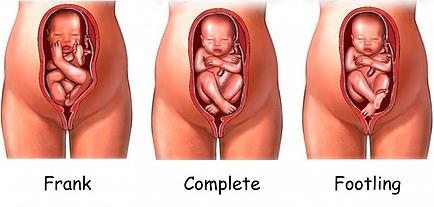When complications occur
Breech
A breech position means the baby presents bottom or feet first, rather than head first.
During pregnancy, many babies are in the breech position. However, most babies turn before 37 weeks.
If your baby is still breech at 37 weeks, the chances of your baby turning by itself are low.
Your doctor or midwife will discuss the implications of this for your birth plan and what options are available.
Your options may include:
- external cephalic version
- vaginal breech birth
- elective caesarean birth (usually performed after 39 weeks).
Breech vaginal birth
You may be suitable for a vaginal breech birth if:
- you go into spontaneous labour
- the estimated weight of your baby is within normal limits
- your baby is in either a complete (flexed) or frank (extended) breech presentation
- an ultrasound scan confirms your baby’s head is not extended
- the size and shape or your pelvis are adequate
- you have no pre-existing complications in your pregnancy.
Types of breech presentations

More information: The Royal Australian and New Zealand College of Obstetricians and Gynaecologists (RANZCOG) – Breech presentation at the end of your pregnancy
External cephalic version (ECV) for breech presentation
ECV is a commonly practiced procedure with a low risk of complications.
ECV can reduce the need for a caesarean birth. The success rate is approximately 40% for first time mothers and 60% for others. If you choose to have an ECV, the procedure is done in hospital.
- A trained doctor gently turns the baby by placing their hands on your abdomen and gently coaxing the baby around so it can be born head first.
- This procedure is done at around 37 weeks, using ultrasound to help see the baby, cord and placenta.
What you need to know
Mother and baby are monitored during the procedure.
There’s a small risk that turning the baby may tangle the cord or separate the placenta from the uterus – in which case an emergency caesarean birth is needed. If the baby is still in the breech position at the end of pregnancy, a caesarean birth may be recommended.
More information:
- Pregnancy, Birth and Baby – External cephalic version (ECV)
- The Royal Australian and New Zealand College of Obstetricians and Gynaecologists (RANZCOG) – Breech presentation at the end of your pregnancy